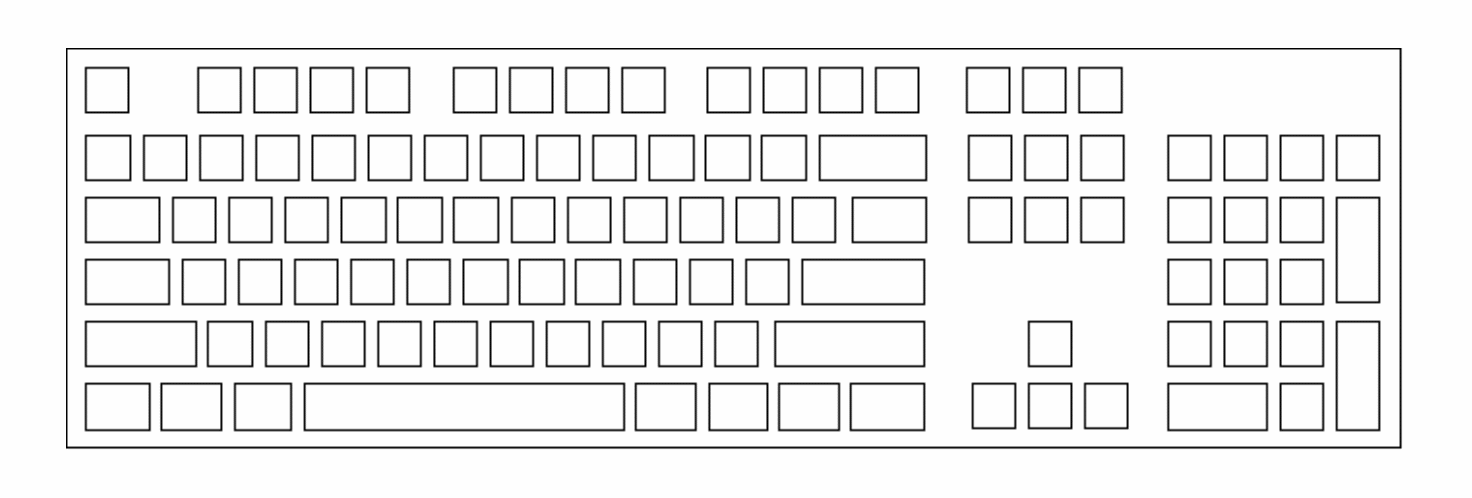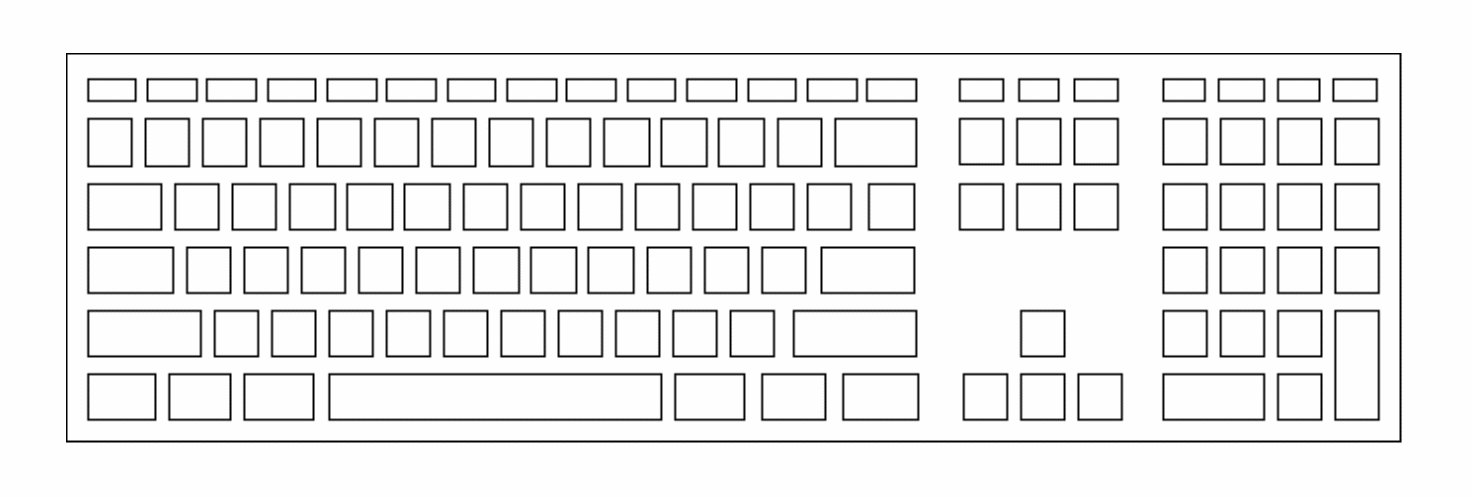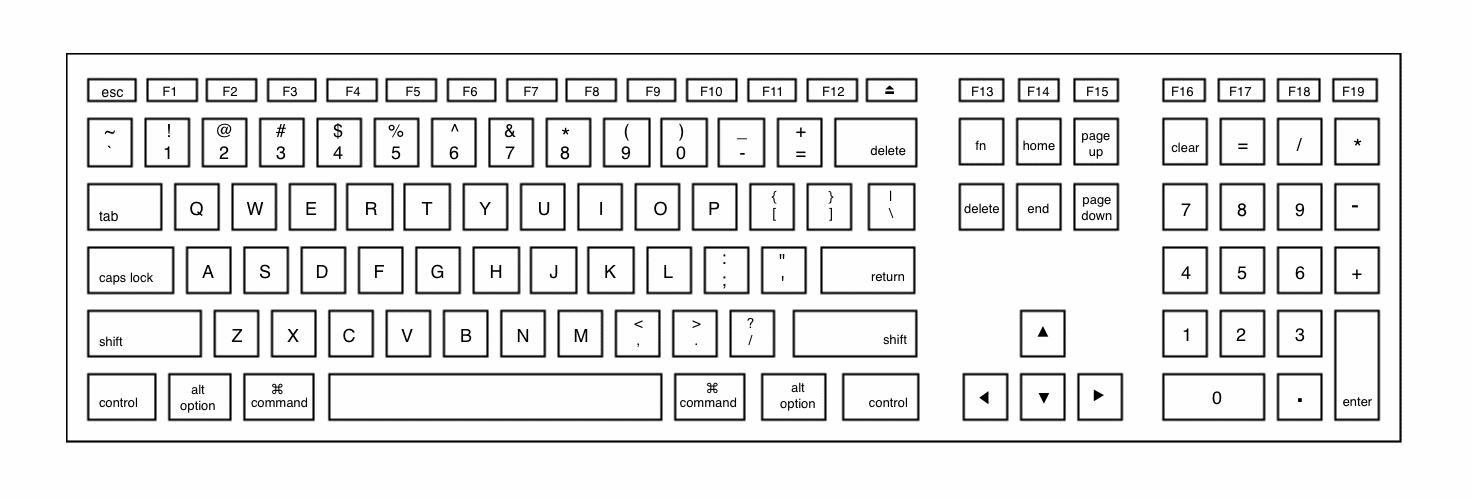The Standard Canadian English Computer Keyboard
=== by Bob Sutherland ===
As a computer teacher I occasionally have to do some research regarding computers and keyboards to support my work in the classroom. During my research I have come across some controversy in the international community regarding which keyboard layout is used in Canada.
Now for those people who have only ever used one keyboard layout let me explain that around the world there are a number of different alphabets and many different languages. To further complicate the situation many countries have at least one or two special keys, such as the currency symbol for their money, that needs to be included on their keyboard. All of these different needs of countries, languages and alphabets means that you should see many different layouts of keys on computer keyboards if you were to travel around the world.
Creating different keyboards for each country, language and alphabet could have been a big problem for computer keyboard factories so the early computer hardware designers came up with a solution. They would design just one physical keyboard that their factories could manufacture. Then by just changing the symbols marked on top of the keys they could use the keyboard in any country for any alphabet and language around the world.
Now in the early days of computers there were many cartoons published that have found their way into school textbooks about the conflicts and battles that took place between computer hardware designers and computer software programmers. By intending to design just one physical keyboard for everyone the computer hardware designers were passing the original problem over to the computer software programmers to solve. When a person using the computer presses the fifty-seventh key on the keyboard there would need to be programming code in the computer software to know what symbol had been marked on top of the key for that person’s country, alphabet and language. A detailed map of the keyboard layout for many different countries, alphabets and languages now had to be included in the software programming code. So what turns out to be a simple solution for the computer hardware engineers creates a lot of extra work for the computer software programmers. It is no wonder they used to fight like siblings.
To create one physical keyboard for everyone the computer hardware designers started with the keyboard of the typewriter and designed the IBM Enhanced 101 key keyboard. The keyboard worked well for United States English but the people of the British Isles decided they needed 102 keys for the British English keyboard. Then there was a country over in southeast Asia that required a 106 key keyboard. Fortunately all of the other countries, alphabets and languages around the world were able to adapt and use one of the three designs, either the 101 key, the 102 key or the 106 key keyboard by just changing the markings on top of the keys.
Now before you go counting how many keys there are on your keyboard let me advise you that many computer manufacturers have modified the original designs. For laptop computers they have tried to reduce the number of keys by removing some duplication so a laptop computer may only have about 89 keys. For desktop computers with a full keyboard often extra keys have been added to control things such as the brightness and contrast of the screen, the volume of the speakers, and controls for playing music and movies on a CD or DVD.
So getting back to the original question of which keyboard is used in Canada we have to consider some facts.
For the past few decades the Canadian federal government has been encouraging a policy of multiculturalism with the intent that if new immigrants maintain some of their culture and foreign language skills they can act as our sales representatives in international trade with their homeland. Therefore we need to have some keyboards and computers available in our country that immigrants and sales staff can use to type a variety of international languages.
Canada is a bilingual country with English and French as our official languages. Most of the population speaks English but there are French or bilingual communities of various sizes scattered throughout the country. French is the dominant language for much of southern Quebec near the St. Lawrence River.
French language instruction in the form of a single course each year, or something more intensive, is provided to the students in many English language schools. I presume a similar form of English language instruction is provided for students in French language schools.
Occasionally Canadians will borrow a word or phrase from the other official language to include in something they are typing.
Reflecting on the above two paragraphs the Canadian English language keyboard must have the capability to type the French language accent marks. The use of accent marks is the main difference between the two languages as far as a keyboard is concerned.
Canada is a very large, sparsely populated country. Most of Canada's population now lives in towns and cities that are near our southern border with the United States of America. As many Canadians regularly cross the border to shop it only makes sense that they will buy and bring home computers and keyboards from the United States to use in their homes.
The Canadian economy is very dependent on trade with the United States. Therefore many Canadian businesses will want to use the same keyboards and computers as their American business trading partners to make communication easier.
Canada’s aboriginal population is now vastly outnumbered by all of the immigrants who have arrived over the past few centuries. Geographically though, most of the map of Canada, including all of the northern regions, is still predominantly bare of human settlement. There are only a few tiny little dots representing isolated, aboriginal communities scattered across the vast majority of the Canadian map surface.
There are many different aboriginal languages in Canada and some communities or regions have developed their own dialect of an aboriginal language. To complicate the situation it was the early church missionaries representing a few different religions from Europe who first transcribed the oral aboriginal languages into a written form and then taught the aboriginals to read and write. Unfortunately the missionaries did not all use the same alphabet for the aboriginal languages so today we have the situation where one Cree speaking community may be using a Latin based alphabet similar to English or French while another Cree community with the same spoken language may be using syllabics as their written alphabet. The two Cree speaking communities would each require very different markings on the keys of their keyboards to type in their own language.
As a teacher working in many English language schools and aboriginal schools across Canada I have seen very few keyboards with syllabics markings on the keys for typing an aboriginal language. Instead what I have seen is software programs on school computers that displayed a large syllabics keyboard across the bottom part of the computer screen with a simple word processor above it. Students in a Native Language class such as Cree, Dene or Inuktitut are then able to use their computer mouse clicking on the syllabic keyboard on the computer screen. Alternatively the students and Native Language teachers can type on a regular Canadian English keyboard by watching the syllabics keyboard markings on their computer screen so they know which keys to press.
Similar to the syllabics keyboards that display on a computer screen I have seen software settings on computers that can allow you to type using the keyboards of many other alphabets, languages and countries. Therefore I could use my Canadian English keyboard but have it behave and type in a word processing program as if I were using a German, Spanish, French or Italian keyboard. I would have to watch the little diagram of a keyboard on the screen to know which keys to press when typing in another language.
Whenever I go shopping on the Internet and look at Apple Macintosh computers for sale in Canada I am given a choice of buying a Canadian English or a Canadian French keyboard. I have always bought the Canadian English keyboard.
I have been aware for a few years now that at least theoretically according to the Internet there are official sounding keyboard layouts with names such as CSA and Multilingual Canadian keyboard design. As a teacher trained and responsible for teaching Typing, Keyboarding and Computer courses I have never received any communication from education or government officials about such keyboards or any diagrams of what they should look like.
What I have received is government education department instructions that in classrooms where the students are being taught in English the teachers and students should be using the full extended Canadian English keyboard with number pad. The keyboards for the Macintosh, Windows and Linux computers should be identical or almost identical and interchangeable. That way the teachers and students will only need to learn keyboarding skills using one keyboard design rather than having to use different keyboards for different types of computers in different classrooms during the school day.
The hundreds of used computers that were donated to northern Canadian schools and libraries by government offices and businesses that I have helped set up almost always came with a Canadian English language keyboard. All of the new computer keyboards that were purchased by the schools where I taught were Canadian English language keyboards unless someone specifically required a different keyboard.
So what does a Canadian English language keyboard look like? Well it looks exactly the same as a United States English language keyboard.
A drawing of the Canadian English keyboard for the Windows Operating System.

Here is a downloadable version of the above picture.:
A photograph of the Canadian English keyboard for the Macintosh Operating System.

This is the preferred Macintosh keyboard for use in Canadian English language schools. The keyboard is almost identical to the keyboards available for UNIX/Linux and MS-DOS/Windows operating systems.
Apple Canada also sells a much smaller keyboard with fewer keys for their Macintosh computers that is not recommended for use in Canadian schools. One reason for rejecting the smaller keyboard is concerns over how compatible it will be when used with software and hardware designed for the other operating systems. There is also the consideration that students and teachers would find it more difficulty trying to learn and practice their keyboarding skills if they had to switch between the smaller Apple keyboards and full size keyboards as they moved around a school using different computers.
Here are all four downloadable versions of the above picture. Pick the size you need.:
- Macintosh keyboard photo (JPEG, 1000 x 260 pixels, 67.3 KB)
- Macintosh keyboard photo (JPEG, 1251 x 326 pixels, 92.3 KB)
- Macintosh keyboard photo (JPEG, 1500 x 390 pixels, 120.5 KB)
- Macintosh keyboard photo (JPEG, 2502 x 651 pixels, 266.8 KB)
My drawings of Windows and Linux keyboards

Here are all three downloadable versions of the above drawing:
- Windows or Linux keyboard with unmarked keys (GIF, 736 x 249 pixels, 14.8 KB)
- Windows or Linux keyboard with unmarked keys (GIF, 1472 x 498 pixels, 36.5 KB)
- Windows or Linux keyboard with unmarked keys (PDF, 20.3 KB, printer ready Canada & U.S.A. letter size page)

In the very first keyboard diagram up above you can see the Windows waving flag logo on two of the keys and the menu logo on one key. This time I used the Linux black diamond called a Meta or Super key instead of trying to draw the Windows logo. I do not think Linux uses the Menu key so I simply typed the word Menu on the key.
Here are two downloadable versions of the above drawing:
- Linux and Windows keyboard with all the keys labelled (GIF, 1472 x 498 pixels, 61.7 KB)
- Linux and Windows keyboard with all the keys labelled (PNG, 1472 x 498 pixels, 37.4 KB)
My drawings of Macintosh keyboards

Here are all three downloadable versions of the above drawing:
- Macintosh keyboard with unmarked keys (GIF, 736 x 249 pixels, 17.6 KB)
- Macintosh keyboard with unmarked keys (GIF, 1472 x 498 pixels, 37.5 KB)
- Macintosh keyboard with unmarked keys (PDF, 20.0 KB, printer ready Canada & U.S.A. letter size page)

Here are two downloadable versions of the above drawing:

